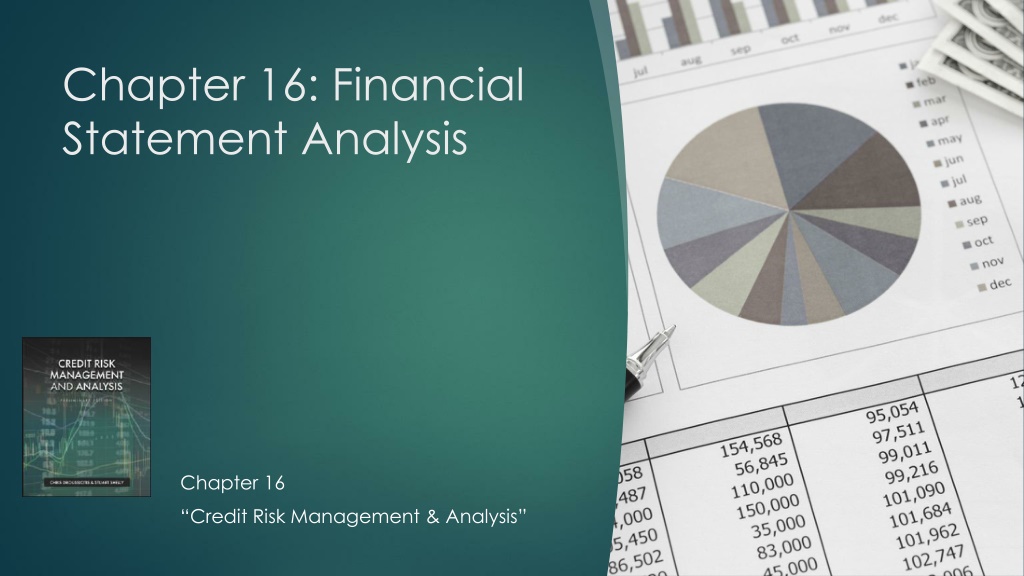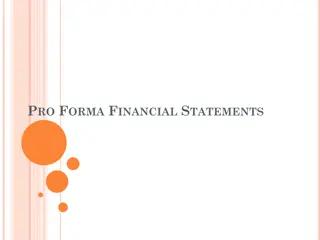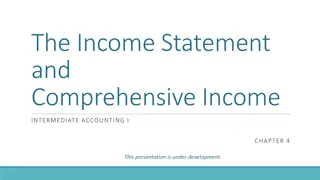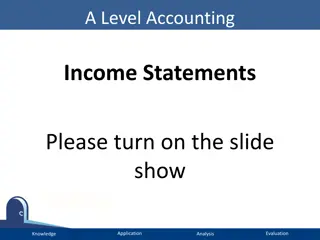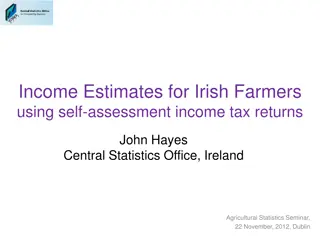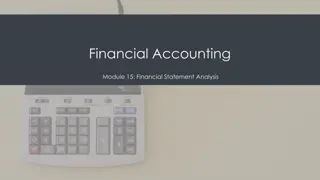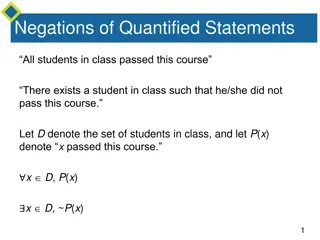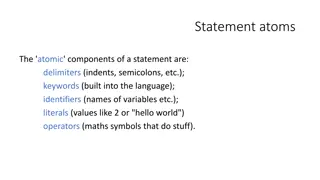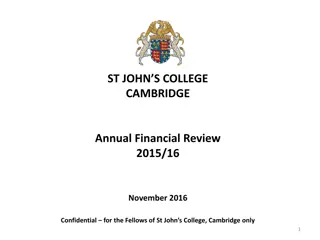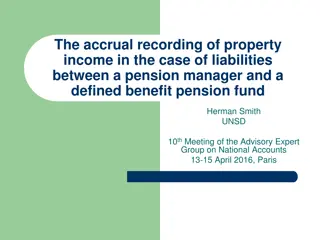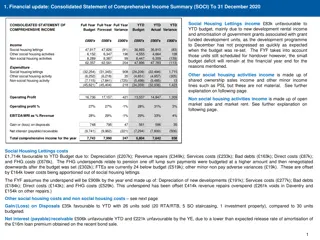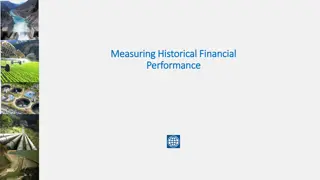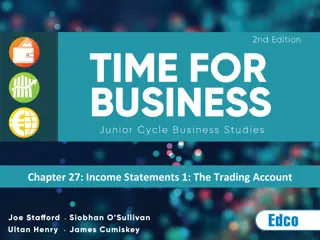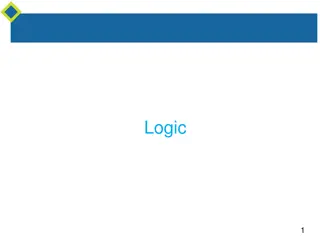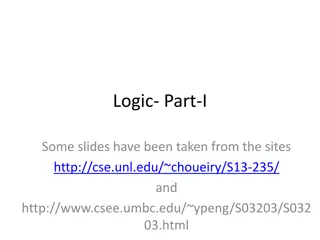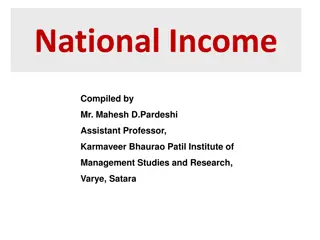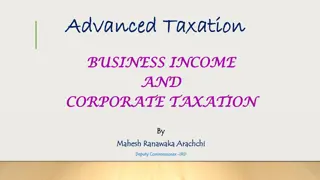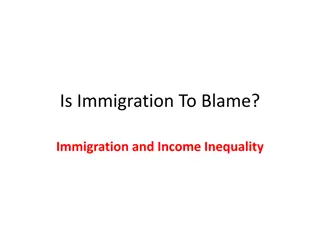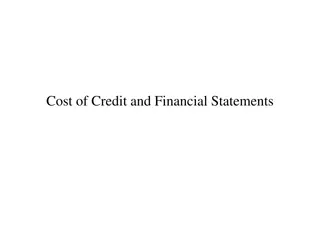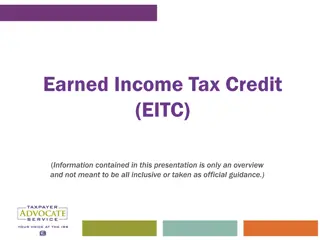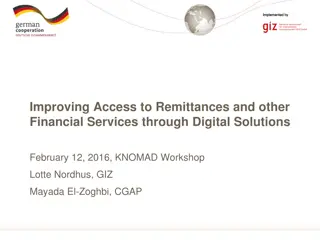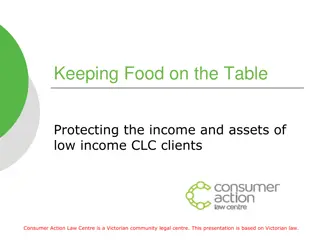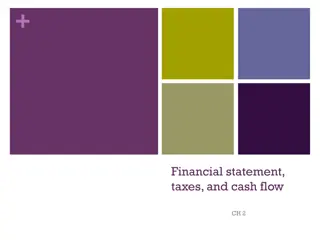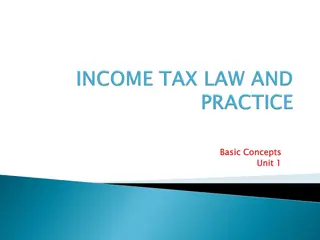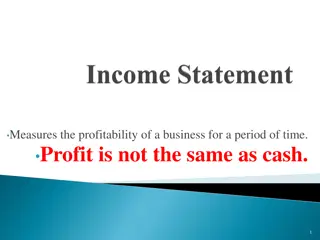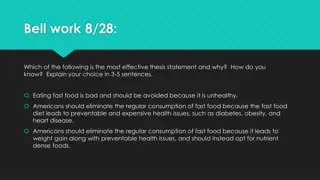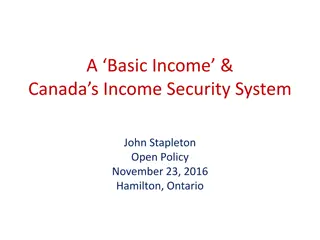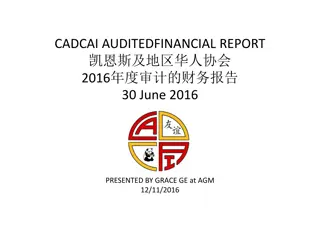Understanding Financial Statements and Income Statement Analysis
The financial statement analysis covers the overview of financial statements, the importance of uniform financial standards for evaluating companies, and a breakdown of the income statement for Celerity Technology Inc. (CTI) in Year 1 and Year 2. The analysis focuses on key metrics such as revenues, expenses, profit margins, and growth rates by geography. It emphasizes the significance of income statements in assessing a company's financial performance and provides insights on how to interpret and compare financial data effectively.
- Financial statements
- Income statement analysis
- Financial performance
- Uniform standards
- Profit margins
Download Presentation

Please find below an Image/Link to download the presentation.
The content on the website is provided AS IS for your information and personal use only. It may not be sold, licensed, or shared on other websites without obtaining consent from the author. Download presentation by click this link. If you encounter any issues during the download, it is possible that the publisher has removed the file from their server.
E N D
Presentation Transcript
Chapter 16: Financial Statement Analysis Chapter 16 Credit Risk Management & Analysis
Financial Statements Overview There are three primary financial statements: income statements, balance sheets, and cash flow statements. Public traded companies are required to include audited financial statements in their annual and quarterly reports. The Securities Exchange Commission (SEC) requires the public traded companies to file one 10K and three 10Q reports per year representing their annual and quarterly performance, respectively. These detailed statements can be found on the company s filings in the SEC s EDGAR system. They are also usually available on the company s website under Investor Relations and other financial websites such as www.finance.yahoo.com and www.google.com/finance. In addition to the statements, the company discusses its performance found in the Management, Discussion, and Analysis (MD&A) section as well as provides detailed footnotes to each of the statements
Understanding Financial Statements To evaluate publicly traded companies, analysts who represent different investors need uniform financial standards that are consistent, accurate, and complete. Public accounting organizations around the world have set up global accounting standards. The biggest organization, the International Financial Reporting Standards (IFRS), is gradually replacing country-specific standards. Developed by the Financial Accounting Standard Board (FASB), the United States still recognizes generally accepted accounting principles (GAAP) regulated by the SEC. However, the United States is gradually unifying to the IFRS standards.
Income Statement The income statement is a summary of the company s profit or loss over a period. It reports the revenues, expenses, and net profit or net loss over a quarter or a full year. It s also referred to as a profit and loss statement or P&L. The income statement drives the company s reported quarterly earnings per share (EPS). It is usually accompanied by a statement of comprehensive income, which reconciles the income statement to account for investments made by owners of the company. The income statement is very useful when comparing revenues, expenses, and profits for the period and for one or more prior periods. For example, this quarter s results can be compared to two prior quarters or the same quarter from last year (this is called year over year or YoY ). The income statement demonstrated in figure 15.1 is basically broken down into top-line revenues and two types of expenses, including cost of revenues and operating expenses. The difference between revenues and these expenses the company s income from operations is calculated before other expenses such as interest and taxes. Net income or the company s bottom line is derived after these expenses are subtracted.
Celerity Technogy Inc. ("CTI") Financial Statement Analysis Income Statement INCOME STATEMENT (000'S) Year 1 Year 2 Operating Ratios for Year 2 9 Revenues by Geography U.S. Europe Asia Total Revenue Rev. Growth 15.0% 16.7% 25.0% 15.6% % Breakdown 82.9% 12.6% 4.5% 100.0% 10 11 12 13 800,000 120,000 40,000 960,000 920,000 140,000 50,000 1,110,000 15 16 17 18 19 Cost of Revenues by Geography U.S. Europe Asia Total Cost of Revenue Gross Margin 62.0% 64.3% 60.0% 62.2% Gross Profit 570,000 90,000 30,000 690,000 293,000 39,000 13,000 345,000 350,000 50,000 20,000 420,000 21 Gross Profit 615,000 690,000 23 24 25 26 27 28 29 30 31 Operating Expenses Administrative & General Marketing Expenses Other Operating Expenses Total Operating Expenses EBITDA Depreciation Amortization EBIT As % of Sales 14.9% 7.2% 1.1% 23.2% 39.0% 5.9% 0.9% 32.3% 145,000 75,000 10,000 230,000 385,000 60,000 10,000 315,000 165,000 80,000 12,000 257,000 433,000 65,000 10,000 358,000 (EBITDA Margin) Deprec. as % of Revenues Amort. as % of Revenues EBIT Margin 33 34 35 36 Interest Expense EBT Taxes Net Income 130,000 185,000 44,400 140,600 120,000 238,000 57,120 180,880 10.8% 21.4% 24.0% 16.3% Interest Rate Tax Rate NI Margin Figure 16.1
Income Statement Revenues Revenue (or sales) is the first line item on the income statement. Revenues represent the total dollar amount realized by companies for the sale of products and services at a given period. Revenues could be itemized by product, segment, division, or geographical location. In analyzing revenues, an analyst looks at the drivers of such revenues. The drivers could be volume, price, or contractual obligations. These drivers will be discussed in later chapters. Expenses Expenses reported in the income statement are generally broken down into two parts: Direct cost or cost of revenue or cost of goods sold (COGS) Indirect cost or operating expenses or selling, general, and administrative expenses (SG&A) Cost of Revenues Cost of revenues (or cost of goods sold (COGS)) includes the direct costs of selling the goods of the company. These expenses include raw material, labor, and overhead (MLO). Cost of revenues captures expenses that are variable based on sales volume or units sold. Operating Expenses Operating expenses include the fixed costs of running a company that are not directly related to the sales volume or number of units sold. Operating expenses are also referred to as selling, general, and administrative expenses (SG&A). SG&A includes administrative costs such as the CEO s salary, marketing costs such as advertising, and general costs such as office supplies and other office expenses. In addition to the SG&A expenses, publicly traded companies include non-cash expenses such as depreciation and amortization
Income Statement Operating Income or EBIT Revenues minus operating expenses result to operating income or earnings before interest and taxes (assuming the depreciation and amortization expenses are included in the Operating Expense section). Usually, private companies exclude depreciation and amortization expenses from the Operating Expense section resulting in earnings before interest, taxes, depreciation, and amortization (EBITDA). Earnings Before Interest, Taxes, Depreciation, and Amortization or EBITDA For publicly traded companies, earnings before interest, taxes, depreciation, and amortization (EBITDA) is not usually found in the income statement. This is calculated by adding back depreciation and amortization (D&A) to EBIT or operating income. This income line is commonly used to estimate the operating cash flow of the company. EBITDA is used in various methods to estimate the value of the firm and is discussed in later chapters. Net Income Net income represents the bottom-line profit or loss of the company after tax and interest expenses and after other non-ordinary expenses such as dividends and one-time or non-recurring expenses. Net income or earnings after taxes represent the value added to last year s earnings.
Balance Sheet Statement The balance sheet represents the wealth or the financial condition of the company. Unlike the income statement, which measures company performance over a quarter or a year, the balance sheet is a snapshot of all a company s assets, representing everything the company owns (cash, equipment, investments, etc.); liabilities, representing what the company owes against those assets and the company s net worth; and shareholder s equity, representing what the owners keep or earned, taken at a moment in time, as demonstrated in figure 16.2 Figure 16.2
Balance Sheet Statement Assets This section of the balance sheet gives a list of the assets of the company. The statement is formatted to start from the most liquid assets to the least liquid. The first section is current assets, representing assets that should turn to cash within the next 12 months. These are followed by non-current assets that includes tangible and intangible assets such as goodwill. Current Assets Current assets include cash and cash equivalents, accounts receivable, inventory and other current assets. Cash and cash equivalents: Cash and cash equivalents represent the deposit account and/or short-term investments of the company. This cash is accessible within a day or two. Accounts receivable: Accounts receivable represent the money owed to the company by the customer and are considered the second-most liquid item on the balance sheet as the customers typically have 30 60 days to pay the company for goods they bought. Inventory: Inventory represents the cost of raw materials, work in process (WIP), and finished goods that are ready to be shipped. Inventory will usually turn into cash in 30 120 days, depending of the type of the inventory the company buys, develops, and sells. Other current assets: Other current assets include money owed to the company for reasons other than customers. It also includes prepaid expenses, which are expenses that are prepaid upfront such as insurance fees and annual license fees.
Balance Sheet Statement Non-Current Assets Non-current assets include both tangible and non-tangible assets. Tangible assets include property, plant, and equipment; long-term investments; and other long-term assets. Intangible assets include goodwill and other intangible assets such as patterns and trademarks. Gross property, plant, and equipment (PP&E): PP&E represent tangible assets such as buildings, land, equipment, cars, and trucks at their book value. The balance sheet ignores any appreciation in asset value. Sometimes the company reports the net PP&E, which represents the value of these assets after all depreciation is subtracted from the gross amount. Long-term investments: These could be investments such as joint ventures or other long-term investments. Goodwill:Goodwill is created when the company is acquired for a price greater than book value. The difference between the acquisition price and book value is recorded as goodwill.
Balance Sheet Statement Liabilities This section of the balance sheet gives a list of the liabilities of the company. The statement is formatted to start from the most liquid to the least liquid. The first section is current liabilities, representing the obligations that the company should pay within the next 12 months. These are followed by long-term liabilities, which are obligations that extend further that a year into the future. Current Liabilities Current liabilities include outstanding payments to suppliers, short-term debts and obligations due within one year such as accounts payable, short-term interest and tax payables, current portions of long-term debt, and other accrued expenses. Accounts payable: These are payment obligations due by the company to suppliers, primarily for purchasing inventory or raw material. Income tax accruals: These are short-term income-related taxes that are payable within a year. Accrued expenses: These are expenses that needed to be paid within a year. These accrued expenses do not include any obligations owed to suppliers. Current portion of long-term debt: This is the company s debt obligations that are due within a year.
Balance Sheet Statement Long-Term Liabilities Long-term debt: Any debt including loans, bonds, or mortgages that are due more than a year are included in this section. Deferred taxes: These are taxes that are deferred, due, and payable in more than a year. Other liabilities: Other liabilities include long-term obligations such as contingent liabilities. These include potential payments due to lawsuits, environmental obligations, and/or insurance payments.
Balance Sheet Statement Net Worth or Shareholder s Equity Shareholder s equity measures the amount by which a company s assets exceed its liabilities at snapshot in time; basically if one sold all that the company owns after paying all the obligations against these assets, the balance left is what the ownership will keep (figure 15.2). Shareholder s equity is also referred to as net worth or book value of equity. Included in this section are common stock, preferred stock, treasury stock, paid-in capital, and other equity and retained earnings. Common stock: This represents the original issuance of equity by the owners and it will go down when the company buys back shares. Preferred stock: This could be an issuance by a third-party investor who expects the company to pay certain fixed dividends (like debt obligations). Treasury stock: Recorded as a negative number on the balance sheet, treasury stock represents shares that have been issued in the past but were repurchased by the company. The amount repurchased will reduce both par value and capital surplus on the balance sheet if the company decides to permanently retire the stock that was repurchased. If the company decides to re-issue the stock sometime in the future, the treasury stock will be set up at a separate account, reducing common stock and shareholder s equity. Paid-in capital: This represents proceeds from any additional equity investments invested in the company. Retained earnings: Retained earnings represent the cumulative income net of loses over time. The retained earnings could also be reducing if the company pays out dividends to shareholders or records loses.
Celerity Technogy Inc. ("CTI") Financial Statement Analysis BALANCE SHEET STATEMENT (000's) Current Assets Cash and Cash Equivalent Accounts Receivable Inventories Prepaid Expenses Total Current Assets Year 1 Year 2 $ Change % Change 7 8 9 45,000 45,000 35,000 10,000 135,000 106,880 60,000 40,000 215,880 61,880 15,000 5,000 (1,000) 80,880 137.5% 33.3% 14.3% -10.0% 59.9% 10 11 12 9,000 14 15 16 17 18 19 20 Property and Equipment Land Building Furniture & Equipment Total Gross P&E Less Accumulated Depreciaition Net P&E Balance Sheet Statement 2,500,000 450,000 50,000 3,000,000 (300,000) 2,700,000 2,500,000 550,000 75,000 3,125,000 (365,000) 2,760,000 100,000 25,000 125,000 (65,000) 60,000 - 0.0% 22.2% 50.0% 4.2% 21.7% 2.2% 22 23 24 25 Long-Term Investments Intagibes Other Long-Term Assets Total Assets 140,000 50,000 10,000 3,035,000 190,000 40,000 11,000 3,216,880 50,000 (10,000) 1,000 181,880 35.7% -20.0% 10.0% 6.0% 27 Liabilities and Owners Equity 29 30 31 32 33 34 Current Liabilities Accounts Payable Accrued Income Taxes Accrued Expenses Current Portion of Long Term Debt Total Current Liabilities 35,000 12,000 10,000 20,000 77,000 40,000 10,000 8,000 10,000 68,000 5,000 (2,000) (2,000) (10,000) (9,000) 14.3% -16.7% -20.0% -50.0% -11.7% 36 Long-Term Debt: 1,200,000 1,180,000 (20,000) -1.7% 38 39 40 Deferred Income Taxes Other Long-Term Liabilities Total Liabilties 1,289,000 7,000 5,000 11,000 6,000 1,265,000 4,000 1,000 (24,000) 57.1% 20.0% -1.9% 42 43 44 45 46 47 48 Owners' Equity Prefered Stock Common Stock Treasury Stock Paid-in-Capital Retained Earnings Total Owners' Equity 1,000,000 746,000 1,746,000 - 1,000,000 25,000 926,880 1,951,880 - 25,000 180,880 205,880 - - - 0.0% - - - 24.2% 11.8% 50 Total Liabilities & Owner's Equity 3,035,000 3,216,880 181,880 6.0%
Cash Flow Statement Net Worth or Shareholder s Equity Shareholder s equity measures the amount by which a company s assets exceed its liabilities at snapshot in time; basically, if one sold all that the company owns after paying all the obligations against these assets, the balance left is what the ownership will keep (figure 15.2). Shareholder s equity is also referred to as net worth or book value of equity. Included in this section are common stock, preferred stock, treasury stock, paid-in capital, and other equity and retained earnings. Common stock: This represents the original issuance of equity by the owners, and it will go down when the company buys back shares. Preferred stock: This could be an issuance by a third-party investor who expects the company to pay certain fixed dividends (like debt obligations). Treasury stock: Recorded as a negative number on the balance sheet, treasury stock represents shares that have been issued in the past but were repurchased by the company. The amount repurchased will reduce both par value and capital surplus on the balance sheet if the company decides to permanently retire the stock that was repurchased. If the company decides to re-issue the stock sometime in the future, the treasury stock will be set up at a separate account, reducing common stock and shareholder s equity. Paid-in capital: This represents proceeds from any additional equity investments invested in the company. Retained earnings: Retained earnings represent the cumulative income net of loses over time. The retained earnings could also be reducing if the company pays out dividends to shareholders or records loses.
Cash Flow Statement The cash flow statement represents the cash inflow and outflow of the company. The cash statement is like the income statement when it comes to measuring performance over a period of time. However, it focuses on the actual cash generated or spent by the business. In a perfect world you might not need both the income and cash flow statements. A perfect scenario is described in figure 15.4 where we use an example of a 9-year-old setting up a lemonade stand. In this humorous example the young 9-year-old Joey decides to set up a lemonade stand in front of his house. His dad helps him with $20 to start his lemonade business. Joe uses the full $20 to buy a box of 100 cups ($5), a lemonade-concentrated juice ($5), and 4 gallons of bottled water ($10). In this story, we assume that he sells all his lemonade and uses all 100 cups (no inventory left). Assuming he sold each lemonade for $1, after the end of the day, Joey will set up an income statement to show his profit. Revenues are recorded at $100 ($1 x 100 cups), minus his cost of $20, showing a profit of $80. This should match his cash on hand. In this case his simple income statement will be the same as his cash flow statement since every transaction was done with all cash. See both statements (figure 16.4).
Cash Flow Statement CASH FLOW STATEMENT Net Income $ 80.00 A perfect scenario is described in figure shown where we use an example of a 9-year-old setting up a lemonade stand. Cash Flows: Plus money that we owe Less money owed to us Net Working Capital $ $ - - $ - In this humorous example the young 9-year-old Joey decides to set up a lemonade stand in front of his house. His dad helps him with $20 to start his lemonade business. Joe uses the full $20 to buy a box of 100 cups ($5), a lemonade-concentrated juice ($5), and 4 gallons of bottled water ($10). In this story, we assume that he sells all his lemonade and uses all 100 cups (no inventory left). Cash $ 80.00 INCOME STATEMENT Assuming he sold each lemonade for $1, after the end of the day, Joey will set up an income statement to show his profit. Revenues are recorded at $100 ($1 x 100 cups), minus his cost of $20, showing a profit of $80. Lemonade Sales: Sold 100 cups @ $1 each 100.00 $ Expenses: Box of 100 Cups Lemonade Concetrate Juice 4 Gallons of Water Total Expenses $ $ 5.00 5.00 10.00 $ This should match his cash on hand. In this case his simple income statement will be the same as his cash flow statement since every transaction was done with all cash. $ 20.00 See both statements Net Income $ 80.00
Cash Flow Statement INCOME STATEMENT If we slightly change the story, you will see a need for creating both the income and cash flow statements. Lemonade Sales: Sold 100 cups @ $1 each 100.00 $ Suppose that while Joey was selling his lemonade, his friend Billy bought a lemonade but did not have any money to pay for it. He was very thirsty, he explained, so Joey allowed Billy to have a lemonade and expect to get his $1 later. Expenses: Box of 100 Cups Lemonade Concetrate Juice 4 Gallons of Water Total Expenses $ $ $ 5.00 5.00 10.00 At the end of the day, Billy has not showed up. $ 20.00 Now if Joey had to build both his income and cash flow statement to keep up with the difference between what he earned and what cash he has, as is demonstrated in the figure 15.5, Joey s income statement will show a profit of $80 since he sold all his lemonade, but when he looks at his cash flow statement, he notices a cash profit of $79. Net Income $ 80.00 CASH FLOW STATEMENT The difference of course is the $1 owed (earned because Joey should eventually get his $1 from Billy). Net Income 80.00 $ This $1 will be recorded as accounts receivable and it will be adjusted in the cash flows statement to reflect the timing difference between income and cash. Cash Flows: Plus money that we owe Less money owed to us Net Working Capital $ $ - (1.00) This timing difference is basically the definition of working capital, as described later in this chapter. We are living is non-perfect world a world of IOUs. $ (1.00) Cash 79.00 $
Cash Flow Statement The cash flow statement also reflects the fact that the company receives and spends cash other than its primary business (these transactions are not recorded in the income statement which represents the company s direct or primary operations). For example, a company may spend money on new equipment, conduct improvements of manufacturing facilities, or decide to issue bonds in the capital markets. The company s cash position per period (going up or down) does not necessarily represent the company s operating health. For example, the company might decide to use extra cash to repay debt. This decision will result in a lower cash outflow, even though it may be positive over time, reducing interest obligations. The cash flow statement, which represents the change in position from one period to the next, has three primary sections: Cash Flow from Operating Activities Cash Flow from Investment Activities Cash Flow from Financing Activities It is important to realize that one could build an entire cash flow statement by looking at 2 years of balance sheets. The difference of each item on the balance sheet from one year to the next represents the activity for that year and can been seen on the cash flow statement.
Cash Flow Statement Building the Cash Flow Statement Spreadsheet The cash flow statement can be fully constructed by using addressing every item of two sequential balance sheets. By the taking the difference of this year s balance sheet to last year s representing this year s activities can be used to build the cash flow statement. Forming the Cash Flow Statement The cash flow statement was built to reconcile income to cash. The first line of the statement is net income, and the last line is free cash flow. The balance sheet statement is presented the same way except the first line on the balance sheet is the cash balance and the last line is retained earnings. The changes of these balance sheet items represent free cash flow and net income, respectively. Starting from net income we first need to add any non-cash items that are included in the income statement, moving upward. This includes depreciation, amortization, deferred taxes, or even deferred interest, representing the cash portion of net income before any timing differences in cost of goods sold and revenue. As you can see in this example, we add depreciation and deferred taxes to net income; both items can be found on the balance sheet, as demonstrated in figure 16.6. After adding or subtracting these items we calculate cash income. Net income can also be found on the balance sheet as the difference in retained earnings from one year to the next.
Celerity Technogy Inc. ("CTI") Financial Statement Analysis BUILDING THE CASH FLOW STATEMENT STEP 1: Taking care of the noncash addbacks BALANCE SHEET STATEMENT CASH FLOW STATEMENT (000's) Current Assets Cash and Cash Equivalent Accounts Receivable Inventories Prepaid Expenses Total Current Assets Year 1 Year 2 $ Change % Change (000's) Net Income Plus Depreciation Plus Amortization Plus/Less Deffered Taxes Cash Income Year 2 180,880 65,000 10,000 4,000 259,880 7 8 9 45,000 45,000 35,000 10,000 135,000 106,880 60,000 40,000 9,000 215,880 61,880 15,000 5,000 (1,000) 80,880 137.5% 33.3% 14.3% -10.0% 59.9% 10 11 12 Cash Flow Statement Building the Cash Flow Statement Spreadsheet 14 15 16 17 18 19 20 Property and Equipment Land Building Furniture & Equipment Total Gross P&E Less Accumulated Depreciation Net P&E ADDBACKS GOING UP FROM NET INCOME TO EBITDA IN THE INCOME STATEMENT 2,500,000 450,000 50,000 3,000,000 (300,000) 2,700,000 2,500,000 550,000 75,000 3,125,000 (365,000) 2,760,000 100,000 25,000 125,000 (65,000) 60,000 - 0.0% 22.2% 50.0% 4.2% -21.7% 2.2% Change in Balance Sheet Increase in Assets Decrease in Assets Increase in Liabilities Decrease in Liabilities Increase in Owner's Equity Decrease in Owner's Equity Cash Flow Negative Positive Positive Negative Positive Negative 22 23 24 25 Long-Term Investments Intagibes Other Long-Term Assets Total Assets 140,000 50,000 10,000 3,035,000 190,000 40,000 11,000 3,216,880 50,000 (10,000) 1,000 181,880 35.7% -20.0% 10.0% 6.0% 27 Liabilities and Owners Equity 29 30 31 32 33 34 Current Liabilities Accounts Payable Accrued Income Taxes Accrued Expenses Current Portion of Long Term Debt Total Current Liabilities 35,000 12,000 10,000 20,000 77,000 40,000 10,000 8,000 10,000 68,000 5,000 (2,000) (2,000) (10,000) (9,000) 14.3% -16.7% -20.0% -50.0% -11.7% 36 Long-Term Debt: 1,200,000 1,180,000 (20,000) -1.7% 38 39 40 Deferred Income Taxes Other Long-Term Liabilities Total Liabilties 1,289,000 7,000 5,000 11,000 6,000 1,265,000 4,000 1,000 (24,000) 57.1% 20.0% -1.9% Tax Expense on the Income Statement minus the change here (5,000) represents the Cash Taxes 42 43 44 45 46 47 48 Owners' Equity Prefered Stock Common Stock Treasury Stock Paid-in-Capital Retained Earnings Total Owners' Equity 1,000,000 746,000 1,746,000 - 1,000,000 25,000 926,880 1,951,880 - 25,000 180,880 205,880 - - - 0.0% - - - 24.2% 11.8% The change represent the Net Income in Year 2 50 Total Liabilities & Owner's Equity 3,035,000 3,216,880 181,880 6.0% Figure 16.6
Celerity Technogy Inc. ("CTI") Financial Statement Analysis BUILDING THE CASH FLOW STATEMENT STEP 2: Working Capital Activities (timing differences) BALANCE SHEET STATEMENT CASH FLOW STATEMENT (000's) Year 1 Year 2 $ Change % Change (000's) Year 2 7 Current Assets Net Income 180,880 8 9 Cash and Cash Equivalent Accounts Receivable 45,000 45,000 106,880 60,000 61,880 15,000 137.5% 33.3% Plus Depreciation Plus Amortization 65,000 10,000 10 11 12 Inventories Prepaid Expenses Total Current Assets 35,000 10,000 135,000 40,000 9,000 215,880 5,000 (1,000) 80,880 14.3% -10.0% 59.9% Plus/Less Deffered Taxes Cash Income 4,000 259,880 Cash Flow Statement Building the Cash Flow Statement Spreadsheet Working Capital Activities 14 Property and Equipment Change in Accounts Receivable (15,000) 15 16 17 Land Building Furniture & Equipment 2,500,000 450,000 50,000 2,500,000 550,000 75,000 100,000 25,000 - 0.0% 22.2% 50.0% Change in Inventory Change in Prepaid Expenses Change in Accounts Payable (5,000) 1,000 5,000 18 19 Total Gross P&E Less Accumulated Depreciaition 3,000,000 (300,000) 3,125,000 (365,000) 125,000 (65,000) 4.2% -21.7% Change in Accrued Income Taxes Change in Accrued Expenses (2,000) (2,000) 20 Net P&E 2,700,000 2,760,000 60,000 2.2% Total Change in Working Capital (18,000) 22 23 Long-Term Investments Intagibles 140,000 50,000 190,000 40,000 50,000 (10,000) 35.7% -20.0% Operating Cash Flow (OCF) 241,880 24 25 Other Long-Term Assets Total Assets 10,000 3,035,000 11,000 3,216,880 1,000 181,880 10.0% 6.0% Cash flow from operating activities (figure 16.7), or working capital, represent changes in current assets and current liabilities on the balance sheet. Out of these sections of the balance sheet we omit cash balances and current-portion long-term debt, as these are included in other sections of the activity sectors. Change in Balance Sheet Cash Flow 26 Increase in Assets Negative 27 Liabilities and Owners Equity Decrease in Assets Positive Increase in Liabilities Positive 29 Current Liabilities Decrease in Liabilities Negative 30 Accounts Payable 35,000 40,000 5,000 14.3% Increase in Owner's Equity Positive 31 Accrued Income Taxes 12,000 10,000 (2,000) -16.7% Decrease in Owner's Equity Negative 32 Accrued Expenses 10,000 8,000 (2,000) -20.0% 33 Current Portion of Long Term Debt 20,000 10,000 (10,000) -50.0% 34 Total Current Liabilities 77,000 68,000 (9,000) -11.7% 35 36 Long-Term Debt: 1,200,000 1,180,000 (20,000) -1.7% 37 38 Deferred Income Taxes 7,000 11,000 4,000 57.1% 39 Other Long-Term Liabilities 5,000 6,000 1,000 20.0% 40 Total Liabilties 1,289,000 1,265,000 (24,000) -1.9% 42 43 Owners' Equity Prefered Stock - - - 44 45 Common Stock Treasury Stock 1,000,000 1,000,000 - - 0.0% - - 46 Paid-in-Capital - 25,000 25,000 47 Retained Earnings 746,000 926,880 180,880 24.2% 48 Total Owners' Equity 1,746,000 1,951,880 205,880 11.8% 50 Total Liabilities & Owner's Equity 3,035,000 3,216,880 181,880 6.0% Figure 16.7
Celerity Technogy Inc. ("CTI") Financial Statement Analysis BUILDING THE CASH FLOW STATEMENT STEP 3: Investment Activites Cash Flow Statement Building the Cash Flow Statement Spreadsheet BALANCE SHEET STATEMENT CASH FLOW STATEMENT (000's) Year 1 Year 2 $ Change % Change (000's) Year 2 7 Current Assets Net Income 180,880 8 Cash and Cash Equivalent 45,000 106,880 61,880 137.5% Plus Depreciation 65,000 9 Accounts Receivable 45,000 60,000 15,000 33.3% Plus Amortization 10,000 10 11 Inventories Prepaid Expenses 35,000 10,000 40,000 9,000 5,000 (1,000) 14.3% -10.0% Plus/Less Deffered Taxes Cash Income 4,000 259,880 12 Total Current Assets 135,000 215,880 80,880 59.9% Working Capital Activities Change in Accounts Receivable 14 Property and Equipment (15,000) 15 Land 2,500,000 2,500,000 - 0.0% Change in Inventory (5,000) 16 17 Building Furniture & Equipment 450,000 50,000 550,000 75,000 100,000 25,000 22.2% 50.0% Change in Prepaid Expenses Change in Accounts Payable 1,000 5,000 18 19 Total Gross P&E Less Accumulated Depreciaition 3,000,000 (300,000) 3,125,000 (365,000) 125,000 (65,000) 4.2% -21.7% Change in Accrued Income Taxes Change in Accrued Expenses (2,000) (2,000) Cash flow from investment activities (figure 16.8) are activities that represent the balance sheet changes between two periods in long-term assets such as property, plant, and equipment, long-term investments, and other assets. Goodwill and intangibles are not included in this section. The changes in PP&E are called capital expenditures (Capex). If the company decides to sell assets, a new line could be created called Asset Disposition, or sometimes the Capex is net of asset sales. 20 Net P&E 2,700,000 2,760,000 60,000 2.2% Total Change in Working Capital (18,000) 22 Long-Term Investments 140,000 190,000 50,000 35.7% Operating Cash Flow (OCF) 241,880 23 24 25 Intagibles Other Long-Term Assets Total Assets 50,000 10,000 3,035,000 40,000 11,000 3,216,880 (10,000) 1,000 181,880 -20.0% 10.0% 6.0% Investment Activities Capital Expenditures (125,000) Investments (Change) (50,000) 27 Liabilities and Owners Equity Change in Long-Term Assets (1,000) Total Financing Activities (176,000) 29 Current Liabilities 30 31 Accounts Payable Accrued Income Taxes 35,000 12,000 40,000 10,000 5,000 (2,000) 14.3% -16.7% Cash Available Before Financing Activities 65,880 32 Accrued Expenses 10,000 8,000 (2,000) -20.0% 33 34 Current Portion of Long Term Debt Total Current Liabilities 20,000 77,000 10,000 68,000 (10,000) (9,000) -50.0% -11.7% Change in Balance Sheet Cash Flow 36 Long-Term Debt: 1,200,000 1,180,000 (20,000) -1.7% Increase in Assets Decrease in Assets Negative Positive 38 39 Deferred Income Taxes Other Long-Term Liabilities 7,000 5,000 11,000 6,000 4,000 1,000 57.1% 20.0% Increase in Liabilities Decrease in Liabilities Positive Negative 40 Total Liabilties 1,289,000 1,265,000 (24,000) -1.9% Increase in Owner's Equity Decrease in Owner's Equity Positive Negative 42 43 44 45 Owners' Equity Prefered Stock Common Stock Treasury Stock 1,000,000 - 1,000,000 - - - - 0.0% - - 46 47 Paid-in-Capital Retained Earnings 746,000 - 25,000 926,880 25,000 180,880 24.2% 48 Total Owners' Equity 1,746,000 1,951,880 205,880 11.8% 50 Total Liabilities & Owner's Equity 3,035,000 3,216,880 181,880 6.0% Figure 16.8
Celerity Technogy Inc. ("CTI") Financial Statement Analysis BUILDING THE CASH FLOW STATEMENT STEP 4: Financing Activites BALANCE SHEET STATEMENT CASH FLOW STATEMENT (000's) Year 1 Year 2 $ Change % Change (000's) Year 2 7 Current Assets Net Income 180,880 8 9 Cash and Cash Equivalent Accounts Receivable 45,000 45,000 106,880 60,000 61,880 15,000 137.5% 33.3% Plus Depreciation Plus Amortization 65,000 10,000 10 Inventories 35,000 40,000 5,000 14.3% Plus/Less Deffered Taxes 4,000 11 12 Prepaid Expenses Total Current Assets 10,000 135,000 9,000 215,880 (1,000) 80,880 -10.0% 59.9% Cash Income 259,880 Working Capital Activities Change in Accounts Receivable Cash Flow Statement Building the Cash Flow Statement Spreadsheet 14 Property and Equipment (15,000) 15 Land 2,500,000 2,500,000 - 0.0% Change in Inventory (5,000) 16 Building 450,000 550,000 100,000 22.2% Change in Prepaid Expenses 1,000 17 Furniture & Equipment 50,000 75,000 25,000 50.0% Change in Accounts Payable 5,000 18 Total Gross P&E 3,000,000 3,125,000 125,000 4.2% Change in Accrued Income Taxes (2,000) 19 20 Less Accumulated Depreciaition Net P&E (300,000) 2,700,000 (365,000) 2,760,000 (65,000) 60,000 -21.7% 2.2% Change in Accrued Expenses Total Change in Working Capital (2,000) (18,000) 22 23 Long-Term Investments Intagibles 140,000 50,000 190,000 40,000 50,000 (10,000) 35.7% -20.0% Operating Cash Flow (OCF) 241,880 24 25 Other Long-Term Assets Total Assets 10,000 3,035,000 11,000 3,216,880 1,000 181,880 10.0% 6.0% Investment Activities Capital Expenditures (125,000) Cash flow from financing activities (figure 16.9) are activities that represent the balance sheet changes between two periods in long-term liabilities and shareholder s equity (except for retained earnings). Investments (Change) Change in Long-Term Assets (50,000) (1,000) 27 Liabilities and Owners Equity 28 Total Financing Activities (176,000) 29 Current Liabilities Cash Available Before Financing Activities 65,880 30 Accounts Payable 35,000 40,000 5,000 14.3% 31 Accrued Income Taxes 12,000 10,000 (2,000) -16.7% 32 Accrued Expenses 10,000 8,000 (2,000) -20.0% Financing Activities 33 Current Portion of Long Term Debt 20,000 10,000 (10,000) -50.0% ST Debt Payments (10,000) 34 Total Current Liabilities 77,000 68,000 (9,000) -11.7% LT Debt Payments (20,000) Change in Long-Term Liabilities Preferred/Common Stock Issuance & Treas. 1,000 36 Long-Term Debt: 1,200,000 1,180,000 (20,000) -1.7% - Equity Contribution Total Financing Activities 25,000 (4,000) 38 Deferred Income Taxes 7,000 11,000 4,000 57.1% 39 40 Other Long-Term Liabilities Total Liabilties 1,289,000 5,000 1,265,000 6,000 1,000 (24,000) 20.0% -1.9% Free Cash Flow Beginning Cash Ending Cash 61,880 45,000 106,880 43 44 Owners' Equity Prefered Stock Error check 0 - - - Change in Balance Sheet Cash Flow 45 Common Stock 1,000,000 1,000,000 - 0.0% Increase in Assets Negative 46 Treasury Stock - - - Decrease in Assets Positive 47 48 Paid-in-Capital Retained Earnings 746,000 - 25,000 926,880 25,000 180,880 Increase in Liabilities Decrease in Liabilities Positive Negative 24.2% 49 Total Owners' Equity 1,746,000 1,951,880 205,880 11.8% Increase in Owner's Equity Positive 50 51 Decrease in Owner's Equity Negative Total Liabilities & Owner's Equity 3,035,000 3,216,880 181,880 6.0% Figure 16.9
Financial Ratio Analysis Understanding how to interpret financial statements does not purely involve looking at the trends between years such as revenue growth to determine how the company is performing. Though this approach is usually the first line of every financial analysis, the analyst needs to get deeper in the analysis to determine specific results that should enhance the assessment of the company s performance. For example, by combining a few items from the income statement and the balance sheet, or by comparing cash flow statement and income statement lines, the analyst could better interpret the company s performance. This process is called ratio analysis and is designed to give the analyst a better story about the performance of the company. Ratio analysis is broken down into liquidity ratios, solvency ratios, operating ratios, and profitability ratios (figure 15.10).
Financial Ratio Analysis Celerity Technogy Inc. ("CTI") Financial Statement Analysis Year 1 Year 2 Definition Understanding how to interpret financial statements does not purely involve looking at the trends between years such as revenue growth to determine how the company is performing. 7 8 9 Trend Analysis Ratios Revenue Growth Stock one-year Return (HPR) 15.6% 25.0% This Year's Revenue / Last Year's Revenue - 1 This Year's SP/ Last Year's SP -1 11 12 13 14 15 16 Liquidity Ratios Current Ratio Quick ratio Cash ratio Accounts Receivable Turnover (ART) Accounts Receivable Days 1.75x 1.17x 0.58x 2.57x 1.85x 0.97x 21.14x 17.26 CA/CL (Cash + A/R) / CL Cash / CL Revenue/Avg AR 365 / ART 18 19 20 21 22 23 24 25 Solvency Ratios Debt/Equity Ratio LTD / Total Capitalization EBITDA / Interest (Coverage Ratio) EBIT / Interest Fixed Charge Coverage Serv./Debt Serv. Cash Avail. For Debt Serv. / Debt Serv. LTD / EBITDA (Leverage Ratio) Though this approach is usually the first line of every financial analysis, the analyst needs to get deeper in the analysis to determine specific results that should enhance the assessment of the company s performance. 68.7% 40.7% 2.96x 2.50x 61.5% 38.1% 3.61x 3.07x 2.05x 0.97x 2.73x LTD / Equity LTD / (LTD + Equity) EBITDA / Interest EBIT / Interest (EBITDA - Capex)/(Int.+ ST + LT Pmts) (CABFA + Int.) / (int. + ST + LT Pmts) LTD / EBITDA 3.12x 27 28 29 30 31 Activity Ratios / Operating Ratios Inventory Ratio (IR) Inventory Ratio - Days Fixed Asset Turnover Ratio Asset Turnover Ratio 11.20x 32.59 0.407x 0.36x Cost of Revenues/Avg Inventory 365 / IR Rev / Avg of FA Rev / Avg of Total Assets For example, by combining a few items from the income statement and the balance sheet, or by comparing cash flow statement and income statement lines, the analyst could better interpret the company s performance. 33 34 35 36 37 38 39 Profitability Ratios Gross Margin EBITDA Margin EBIT Margin Return on Assets (ROA) Gross Return on Assets Return on Equity (ROE) 64.1% 40.1% 33.9% 62.2% 39.0% 33.2% 4.8% 11.8% 8.1% Gross Margin / Revenues EBITDA / Revenue EBIT / Revenue NI / Avg Assets EBIT / Avg Assets NI / Avg Equity 50 51 Other Ratios Altma's Z-score 2.15x 2.67x This process is called ratio analysis and is designed to give the analyst a better story about the performance of the company. 53 54 Z Formula Z = 1.2x(WC/TA) + 1.4x(RE/TA)+3.3x(EBIT/TA)+0.6x(MVE/Liabilities) + 0.99x(Sales/TA) 56 57 58 59 WC = Working Capital TA=Total Assets RE=Retained Earnings MVE=Market Value of Equity Ratio analysis is broken down into liquidity ratios, solvency ratios, operating ratios, and profitability ratios (figure 15.10). 61 62 63 64 Z-Score 1.8x or less Between 1.8 - 3.0 3.0 or above Bankruptcy Likely Uncertain Not likely Figure 15.10
Financial Ratio Analysis Liquidity Ratios Liquidity ratios measure how the company manages cash. Celerity Technogy Inc. ("CTI") Financial Statement Analysis This of course is more relevant when the company is in distress and having liquidity is its top priority. LIQUIDITY RATIO ANALYSIS Year 1 Year 2 Definition 8 Current Ratio 9 Quick ratio 10 Cash ratio 11 Accounts Receivable Turnover (ART) 12 Accounts Receivable Days 1.75x 1.17x 0.58x 3.17x 2.45x 1.57x 21.14x 17.26 CA/CL (Cash + A/R) / CL Cash / CL Revenue/Avg AR 365 / ART The following ratios are considered liquidity ratios (figure 16.11). Figure 16.11
Financial Ratio Analysis Liquidity Ratios Current ratio: Current assets/current liabilities. This ratio measures the ability of the company to pay off its short- term obligations such as payment to vendors or accrued taxes by liquidating its current assets, basically using the cash balances and proceeds from turning receivable and inventory into cash. Companies with lower than 1x current ratio, by definition, do not have enough liquidity to cover their short-term obligations. The example shows that the current ratio improves from 1.75x in 2016 to 2.57x in 2017, showing that even if the company s liquidity is cut in half it has enough cash left to cover its short-term obligations. This indicates the ability to avoid insolvency for the near future. Quick ratio: (Cash and cash equivalents + accounts receivable)/current liabilities. This ratio, also known as acid test ratio, has the same denominator as the current ratio but better represents the immediate liquidity of the company. Sometimes, converting inventory to cash is more challenging. In distressed companies where liquidity is the most important assessment of insolvency, inventory is usually sold at a discount to what is reported in the books. In this case the current ratio could be overestimating the company s liquidity position. Accounts receivable turnover (ART) and days: ART = Revenue/average receivables and ART/365 days. This ratio is called a mixed ratio as it combines items from the income statement and balance sheet. In most cases when an analyst combines items from the income statement and balance sheet, he or she needs to use the average approach for the balance sheet due to the application of periodic information to snapshot information. ART takes the revenue divided by the average receivable amounts between periods found on the balance sheet. This ratio represents how many times a year the receivables convert to cash revenue. Taking that result further, someone can calculate how often the receivables are paid. In the example (figure 15.11), the company shows that the receivables turned 21 times per year or every 17.3 days.
Financial Ratio Analysis Celerity Technogy Inc. ("CTI") Financial Statement Analysis SOLVENCY RATIO ANALYSIS Year 1 Year 2 Definition Solvency Ratios 8 Debt/Equity Ratio 9 LTD / Total Capitalization 10 EBITDA / Interest (Coverage Ratio) 11 EBIT / Interest 12 LTD / EBITDA (Leverage Ratio) 13 Debt Service Coverage 14 Fixed Charge Coverage Serv./Debt Serv. 15 Fixed Charge Coverage Serv. Incl. WC/Debt Serv. 16 Fixed Charge Coverage Serv. Incl. WC & Cash Tax /Debt Serv. 68.7% 40.7% 2.96x 2.42x 3.12x 60.5% 37.7% 3.61x 2.98x 2.73x 1.24x 2.05x 1.93x 1.58x LTD / Equity LTD / (LTD + Equity) EBITDA / Interest EBIT / Interest LTD / EBITDA (CABFA + Int.) / (Int. + ST + LT Pmts) (EBITDA - Capex)/(Int.+ ST + LT Pmts) (EBITDA - Capex - WC)/(Int.+ ST + LT Pmts) (EBITDA - Capex - WC)/(Int.+ ST + LT Pmts) Solvency ratios measure how a company manages debt. Debt can be a friend or a foe. Using the right amount of debt to grow your business is considered good and effective management. Debt though, a lot of it, can put a lot of pressure on the company s performance. Solvency ratios include debt to equity capitalization ratio or long-term debt to total capitalization; coverage ratio or EBITDA to interest expenses, EBIT to interest expenses, fixed charge coverage, cash flow available for debt service to debt service; and leverage ratio of long-term debt to EBITDA. Figure 16.12 All these are important ratios that gives the analyst a clear understanding of the company s solvency status (figure 16.12).
Financial Ratio Analysis Solvency Ratios Debt to equity: Debt/equity. This ratio is generally used for comparing the strength of the equity as it compares to its debt, essentially for investment-grade companies (BBB+ and better under Standards & Poor s grading system) that have a debt-to-equity ratio of less than 1x, showing that the composition of book value of equity is higher than the value of debt. Companies with higher than 1x are considered riskier as the debt is higher than the equity. Total capitalization:Total debt/(Total debt + shareholders equity) or long-term debt/(Long-term debt + shareholders equity): This ratio measures the proportion of debt in the company s capital structure. This ratio is a very common ratio to measure balance sheet leverage, an important measurement for a company to effectively access the capital markets. Coverage ratios: EBITDA/interest expense and EBIT/interest, Both ratios could be found in many loan agreements as financial covenant. This covenant measures how much cushion a company needs to be able to make its periodical debt obligations such as interest expenses. Other coverage ratios are fixed-charge coverage and cash flow available for debt service to debt service. These ratios are more specific to the ability of the company to make its debt obligations, both principal and interest payments.
Financial Ratio Analysis Solvency Ratios Leverage ratio: Total debt/EBITDA or long-term debt/EBITDA: This one of the most popular solvency ratios. This ratio is typically included as a covenant in many loan agreements, primarily for companies that are non-investment grade (BB- or below rated by Standard & Poor). It s also a market benchmark for raising debt in the loan and bond markets. Even the government, after the financial crisis, implemented guidelines to discourage regulated banks to lend money to companies that had a ratio higher than 6x. In 2013, the federal government published the Leveraged Lending Guidelines to guide banks to run debt capacity measurements before providing credit. This ratio measures how long it will take a company to pay off its debt. In a later chapter regarding debt capacity, this ratio is one of the ratios that we will use to derive debt capacity at certain transactions.
Financial Ratio Analysis Solvency Ratios Altman s Z-score: Altman s Z-score measures the credit strength of a publicly traded manufacturing company that faces bankruptcy. The five combined ratios, as illustrated, measure the strength of the company s cash collateral and the likelihood of bankruptcy. Four out of the five ratios have total assets as the denominator, putting emphasis on the relationship between income and cash flow to the collateral of the company, a special relevant factor when a company is facing bankruptcy. These ratios include working capital/total assets, retained earnings/total assets, EBIT/total assets, and sales/total assets. The other ratio, market value of equity/total liabilities, measures the company s market value of the equity in relationship to the total liabilities. In most distress situations where the company is facing bankruptcy, the stock price will significantly decline and simultaneously the liability increases. As a result, the company finances it loses by accessing its credit facilities (figure 16.13). Celerity Technogy Inc. ("CTI") Financial Statement Analysis Each ratio that makes the combined five-ratio formula called Z-Score has different weights assigned to calculate the credit strength of the company. If the company s Z-score is less than 1.8x, the likelihood of bankruptcy is high. Between 1.8x and 3.0x results in uncertainty; in this case what is most important is the negative or positive trend to or away from bankruptcy. The likelihood of bankruptcy is remote if the Z- score is calculated at 3x or above, indicating that the numerator number of each ratio has a relationship to with collateral that is healthy Z-SCORE SOLVENCY RATIO ANALYSIS Year 1 2.1X Year 2 2.7X 7 Altma's Z-score 9 Z Formula 10 Z = 1.2x(WC/TA) + 1.4x(RE/TA)+3.3x(EBIT/TA)+0.6x(MVE/Liabilities) + 0.99x(Sales/TA) 12 WC = Working Capital 13 TA=Total Assets 14 RE=Retained Earnings 15 MVE=Market Value of Equity 17 Z-Score 18 1.8x or less 19 Between 1.8 - 3.0 20 3.0 or above Bankruptcy Likely Uncertain Not likely Figure 16.13
Financial Ratio Analysis Activity or Operating Ratios These ratios measure how well and efficiently the company manages the overall business operations including inventory, working capital, revenue, and cost. Celerity Technogy Inc. ("CTI") Financial Statement Analysis For example, the hotel sector uses occupancy ratio (OR), which represents the percentage number of rooms booked divided by the total available rooms. It is a perfect example to measure how active the hotel is with less vacancies. ACTIVITY RATIOS / OPERATING RATIOS Year 1 Year 2 Definition 8 9 Inventory Ratio (IR) Inventory Ratio - Days Fixed Asset Turnover Ratio Asset Turnover Ratio 11.20x 32.59 0.407x 0.36x Cost of Revenues/Avg Inventory 365 / IR Rev / Avg of FA Rev / Avg of Total Assets The restaurant sector uses turnover ratio, which represents how often tables are turned over or reused during a lunch shift. 10 11 For a manufacturing company, inventory turnover measures how well the company manages inventory (figure 16.14). Figure 16.14
Financial Ratio Analysis Activity or Operating Ratios Gross margin: Gross profit/revenues: This is one of the most common profitability ratios. This ratio, usually expressed as a percentage, measures what the direct profit of a unit of sale is. In figure 15, a gross margin of 62.2% (2017) is stating that every $1 of unit sale yields 62.2 cents of gross profit. EBITDA margin and EBIT margin: EBITDA/revenues and EBIT/revenues: These ratios measure the percentage profit after operating expenses for every single unit of sale. EBITDA represents profit before depreciation and amortization, reflecting as close to cash profit as possible. Return on assets (ROA) and gross return on Assets: Net income/average total assets and EBIT/total assets: This ratio represents the percentage of income that the company generates from the all the assets it owns. Based on figure 15 the ROA is 4.8%, which basically means that if the company decides to sell its assets at book value of an average $3 billion and deposit it at a bank, they would do better than 4.8% return. Return on equity (ROE):Net income/average total shareholder s equity: This ratio takes the ROA one step further. Since the value of the assets are offset by liabilities, the net difference, which is owner s equity, represents the book value of the investment in the company. ROE measures the return on the shareholders equity or how much net income the company generates for every $1 of investment value.
Financial Ratio Analysis Activity or Operating Ratios Gross margin: Gross profit/revenues: This is one of the most common profitability ratios. This ratio, usually expressed as a percentage, measures what the direct profit of a unit of sale is. In figure 15, a gross margin of 62.2% (2017) is stating that every $1 of unit sale yields 62.2 cents of gross profit. EBITDA margin and EBIT margin: EBITDA/revenues and EBIT/revenues: These ratios measure the percentage profit after operating expenses for every single unit of sale. EBITDA represents profit before depreciation and amortization, reflecting as close to cash profit as possible. Return on assets (ROA) and gross return on Assets: Net income/average total assets and EBIT/total assets: This ratio represents the percentage of income that the company generates from the all the assets it owns. Based on figure 15 the ROA is 4.8%, which basically means that if the company decides to sell its assets at book value of an average $3 billion and deposit it at a bank, they would do better than 4.8% return. Return on equity (ROE):Net income/average total shareholder s equity: This ratio takes the ROA one step further. Since the value of the assets are offset by liabilities, the net difference, which is owner s equity, represents the book value of the investment in the company. ROE measures the return on the shareholders equity or how much net income the company generates for every $1 of investment value.
